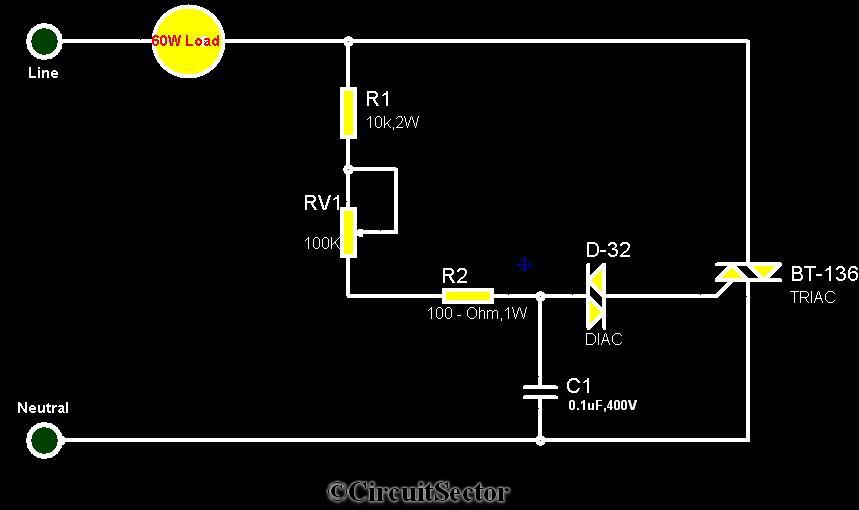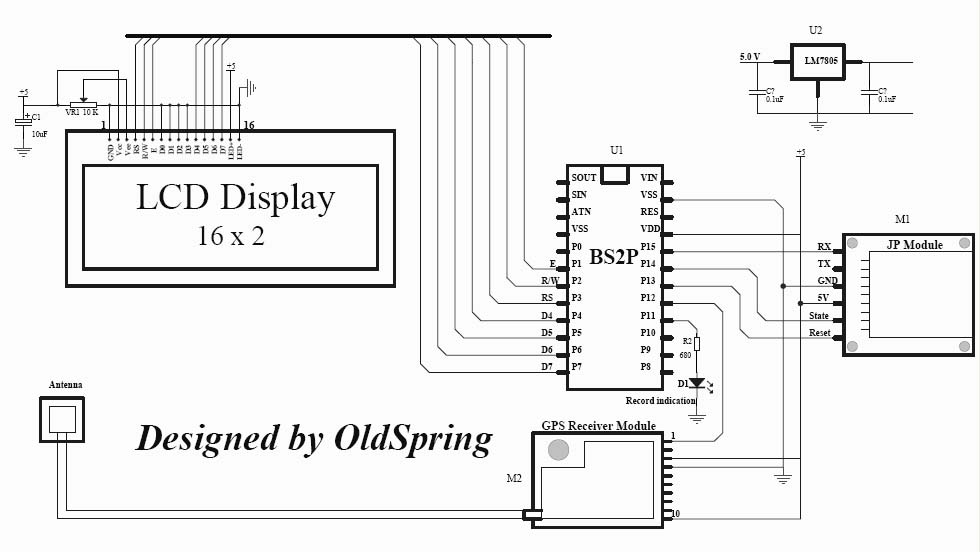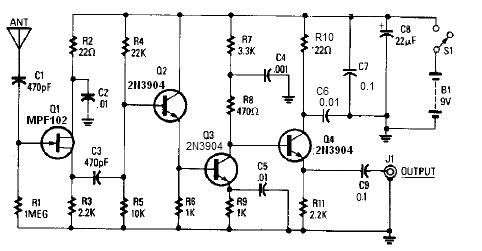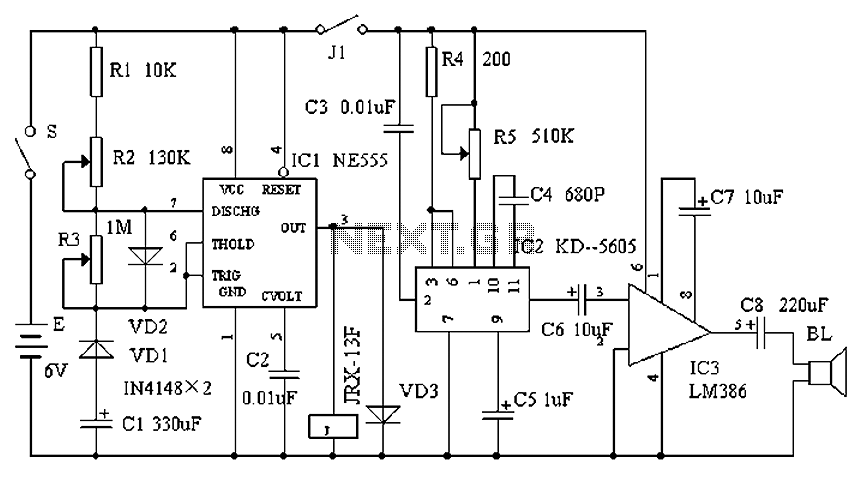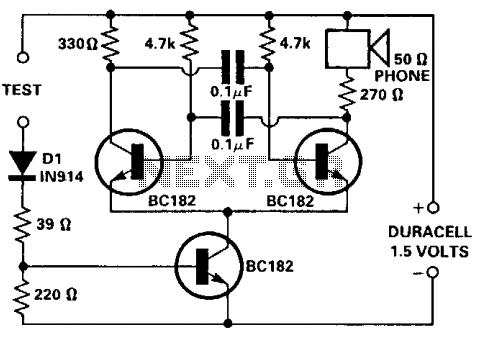
simple rf id reader module design
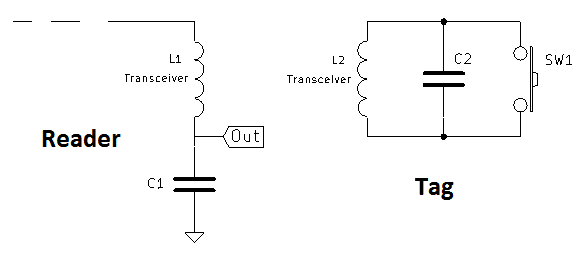
A coil of approximately 1 mH is utilized for both sides of the circuit. Given a chosen frequency of 125 kHz, the required capacitor value is calculated to be 1.62 nF, with a standard value of 1.5 nF selected. L1 is driven by a low-impedance 125 kHz oscillator, which can output either a sine or square wave, as the LC circuit filters out unwanted harmonics present in the square wave. If the inductor's quality factor (Q) is high, the output voltage can exceed the oscillator's output; instances of 100 Vpp have been observed when the LC circuit is fed with 5 Vpp. The output waveform at the top of C1 manifests as a sine wave at a frequency of 125 kHz. When a tag is brought near the reader, the L2 and C2 pair captures the 125 kHz waveform through L2, allowing observation of a 125 kHz sine wave at C2. It is noted that the voltage peak-to-peak (Vpp) at C1 decreases upon closing switch SW1 due to loading of L1's magnetic field via L2. This setup allows for modulation of the output waveform, akin to Morse code signaling. The RFID passive tags utilize a specific modulation scheme, with the EM4100 protocol being selected for this application. L1 and C6 are the primary components, corresponding to L1 and C1 in the referenced figure. The circuitry on the left side of L1 drives the LC circuit, while the right side of C6 reads signal changes. C1 AC couples the 125 kHz clock signal to the circuit. Resistors R1 and R2 provide biasing for transistor Q1, while R4 limits its base current. Q1 drives a push-pull follower formed by transistors Q2 and Q3, which outputs a low impedance signal. Diodes D2 and D3 prevent distortion during crossover at the zero level. It is important to note that these measurements are taken with the tag in close proximity to the reader; moving the tag approximately 5 cm away may result in undetectable signals even with an oscilloscope. Therefore, filtering and amplification of the signal are necessary for subsequent processing by a microcontroller. The signal in question is an AC signal, requiring either a dual supply or a virtual ground for operational amplifiers (OP-AMPs). Assuming a single 5 V supply, the midpoint is set at +2.5 V, designating this as ground. In this configuration, +5 V becomes the new +2.5 V, and 0 V represents -2.5 V, effectively creating a dual supply. To maintain a low output impedance at this supply, an OP-AMP buffers the +2.5 V point, which is high impedance due to resistors R15 and R16. The filter design aims to boost a square wave at a specific frequency while attenuating other frequencies. A square wave inherently contains numerous harmonics of its fundamental frequency, particularly evident in its rise and fall times. To eliminate these harmonics while preserving the fundamental frequency, a filter design is implemented. The output signal, SignalOut, originates from the envelope detector. Capacitor C2 and resistor R3 form a high-pass filter to AC couple the input, with diode D1 providing protection for the non-inverting input.
The circuit described operates as a basic RFID reader system, utilizing an LC circuit for resonant frequency detection and modulation. The choice of components, including the inductor L1 and capacitor C1, is crucial for achieving the desired resonant frequency of 125 kHz, which is essential for effective communication with passive RFID tags. The use of a low-impedance oscillator ensures that the LC circuit is driven efficiently, enabling the generation of high output voltages that can facilitate reliable tag detection.
The modulation of the output signal is a key aspect of RFID technology, allowing for the transmission of data from the passive tag to the reader. The inclusion of a push-pull output stage enhances the circuit's ability to drive subsequent stages with low output impedance, ensuring minimal signal distortion. The design also incorporates protective elements, such as diodes, to safeguard against potential signal distortion during transitions.
In summary, this schematic represents a fundamental approach to RFID signal processing, highlighting the importance of component selection, circuit configuration, and signal integrity in the design of effective RFID systems. The methodology employed in this design can be adapted and expanded upon for various applications within the field of wireless communication and RFID technology.Used a coil of about 1mH for both sides. Since my chosen frequency was 125 KHz, my capacitor should be 1. 62nF according to the following equation; I picked 1n5 standard value. L1 is driven via a low-impedance 125 KHz oscillator, can be a sine or a square wave since theLC circuit will filter out the unwanted harmonics that are presented in a square wave. If the Q of the inductor is high, then a voltage that is greater than the oscillator`s output is going to be present in the Out . I`ve seen 100 Vpp when I fed the LC circuit with 5Vpp! So, the Out waveform at the top of the C1 is a sine wave of a 125 KHz frequency. Now, the fun thing begins when we put the tag near the reader. L2, C2 pair picks up the 125KHz waveform via L2. So, if you scope C2, you will see 125 KHz sine wave. Now, if you scope Out , you will see that Vpp at C1 will drop when we close the switch SW1. That is because we load L1 ²s magnetic field via L2. Now, push the button like you are sending aMorsecode and watch the Output waveform on the scope. Aha, modulation! Simple! That is how real RFID passive tags work. However, instead of sending Morse code, they modulate the signal with their specific modulation scheme. I am going to work with EM4100 protocol since it is widely used. OK, L1 and C6 are our main guys. They are the components that are mentioned before as L1 ³ and C1 ³ in Figure 1. The circuitry on the left side of L1 is used to drive this LC circuit, and right side of C6 is used to read the changes in the signal.
C1 AC couples the clock signal of 125KHz to the circuit. R1 and R2 biases the transistor Q1. R4 limits its base current. Q1 drives the input of push-pull follower formed by Q2 and Q3. A push-pull follower will drive the signal at low output impedance. D2 and D3 prevents distortions at the cross-overs from zero level. Of course, these measurements are made with the tag almost touching the reader. If we move the tag away about 5 cm from the reader, we may not be able to see the signal even with the oscilloscope. So, we have to filter and amplify this signal and make it ready to be processed by a microcontroller later on.
As you can see above, the signal we are dealing with is an AC signal. To deal with AC signals with the OP-AMPs, you need either a dual supply which goes to negative (for example -12V, +12V), or you need a virtual ground. We are going to assume that half point of our supply voltage is ground. So, if we are using a 5V single supply, our half point is +2. 5V. If +2. 5V is ground, then +5V is our new +2. 5V and 0V is our new -2. 5V. There you have it, a dual supply. We need the output impedance of this supply low, so we use an OP-AMP to buffer the +2. 5V point which is high impedance due to R15 and R16, and we get a low impedance output as shown: OK, now that we have solved that problem, let`s go back to our filter design.
We have a square wave at certain frequency that we want to boost. While boosting the desired frequency we want to kill the other frequencies. But we see a bump there; square wave. A square wave is a signal that includes lots of harmonics (theoretically; infinity) of its actual frequency. These harmonics are hidden in the rise and fall waves, sharper the rise and fall, more the harmonics count.
So, that means, if you low pass filter a square wave -that is not letting higher frequencies to pass a filter, you delete those harmonics and remember, those harmonics are in rise and fall times. Thus, you end up with a sine wave. We do not want that, that`s why we are going to let these frequencies pass as the way they are, however we are going to boost the original frequency.
To do this, we have a filter design like follows: SignalOut is our input coming from the envelope detector. C2 and R3 form a high pass filter to AC couple the input, and D1 protects the non-inverting i 🔗 External reference
The circuit described operates as a basic RFID reader system, utilizing an LC circuit for resonant frequency detection and modulation. The choice of components, including the inductor L1 and capacitor C1, is crucial for achieving the desired resonant frequency of 125 kHz, which is essential for effective communication with passive RFID tags. The use of a low-impedance oscillator ensures that the LC circuit is driven efficiently, enabling the generation of high output voltages that can facilitate reliable tag detection.
The modulation of the output signal is a key aspect of RFID technology, allowing for the transmission of data from the passive tag to the reader. The inclusion of a push-pull output stage enhances the circuit's ability to drive subsequent stages with low output impedance, ensuring minimal signal distortion. The design also incorporates protective elements, such as diodes, to safeguard against potential signal distortion during transitions.
In summary, this schematic represents a fundamental approach to RFID signal processing, highlighting the importance of component selection, circuit configuration, and signal integrity in the design of effective RFID systems. The methodology employed in this design can be adapted and expanded upon for various applications within the field of wireless communication and RFID technology.Used a coil of about 1mH for both sides. Since my chosen frequency was 125 KHz, my capacitor should be 1. 62nF according to the following equation; I picked 1n5 standard value. L1 is driven via a low-impedance 125 KHz oscillator, can be a sine or a square wave since theLC circuit will filter out the unwanted harmonics that are presented in a square wave. If the Q of the inductor is high, then a voltage that is greater than the oscillator`s output is going to be present in the Out . I`ve seen 100 Vpp when I fed the LC circuit with 5Vpp! So, the Out waveform at the top of the C1 is a sine wave of a 125 KHz frequency. Now, the fun thing begins when we put the tag near the reader. L2, C2 pair picks up the 125KHz waveform via L2. So, if you scope C2, you will see 125 KHz sine wave. Now, if you scope Out , you will see that Vpp at C1 will drop when we close the switch SW1. That is because we load L1 ²s magnetic field via L2. Now, push the button like you are sending aMorsecode and watch the Output waveform on the scope. Aha, modulation! Simple! That is how real RFID passive tags work. However, instead of sending Morse code, they modulate the signal with their specific modulation scheme. I am going to work with EM4100 protocol since it is widely used. OK, L1 and C6 are our main guys. They are the components that are mentioned before as L1 ³ and C1 ³ in Figure 1. The circuitry on the left side of L1 is used to drive this LC circuit, and right side of C6 is used to read the changes in the signal.
C1 AC couples the clock signal of 125KHz to the circuit. R1 and R2 biases the transistor Q1. R4 limits its base current. Q1 drives the input of push-pull follower formed by Q2 and Q3. A push-pull follower will drive the signal at low output impedance. D2 and D3 prevents distortions at the cross-overs from zero level. Of course, these measurements are made with the tag almost touching the reader. If we move the tag away about 5 cm from the reader, we may not be able to see the signal even with the oscilloscope. So, we have to filter and amplify this signal and make it ready to be processed by a microcontroller later on.
As you can see above, the signal we are dealing with is an AC signal. To deal with AC signals with the OP-AMPs, you need either a dual supply which goes to negative (for example -12V, +12V), or you need a virtual ground. We are going to assume that half point of our supply voltage is ground. So, if we are using a 5V single supply, our half point is +2. 5V. If +2. 5V is ground, then +5V is our new +2. 5V and 0V is our new -2. 5V. There you have it, a dual supply. We need the output impedance of this supply low, so we use an OP-AMP to buffer the +2. 5V point which is high impedance due to R15 and R16, and we get a low impedance output as shown: OK, now that we have solved that problem, let`s go back to our filter design.
We have a square wave at certain frequency that we want to boost. While boosting the desired frequency we want to kill the other frequencies. But we see a bump there; square wave. A square wave is a signal that includes lots of harmonics (theoretically; infinity) of its actual frequency. These harmonics are hidden in the rise and fall waves, sharper the rise and fall, more the harmonics count.
So, that means, if you low pass filter a square wave -that is not letting higher frequencies to pass a filter, you delete those harmonics and remember, those harmonics are in rise and fall times. Thus, you end up with a sine wave. We do not want that, that`s why we are going to let these frequencies pass as the way they are, however we are going to boost the original frequency.
To do this, we have a filter design like follows: SignalOut is our input coming from the envelope detector. C2 and R3 form a high pass filter to AC couple the input, and D1 protects the non-inverting i 🔗 External reference
